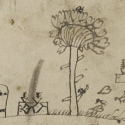Much of my work in digital manuscript studies has been informed by a simple question: is this something I can show to my parents? I am the only person among my family and childhood friends to pursue graduate studies in the humanities, and when others take an interest in my work, I try to provide resources that do not depend on specialized knowledge or institutional subscriptions. This question can also be framed in broader terms for scholars interested in public engagement: how can we make our research accessible and engaging for nonspecialists? How can scholars working on the material culture of previous periods demonstrate the relevance of such studies now? And how can digital resources enable us to learn from communities outside the traditional bounds of academia?
I recently confronted these questions while examining a late-fifteenth-century astronomical anthology, written in German and Latin close to the city of Nuremberg, and now identified as Philadelphia, University of Pennsylvania, Kislak Center for Special Collections, Rare Books and Manuscripts, LJS 445. This codex, which you can see in my video orientation below, is remarkable for its inclusion of material from three incunables, making it a clear example of the transmission of knowledge from print to manuscript.
My own fascination with LJS 445 began when I opened it for the first time and saw a charming sketch of a man on the first page. Turning to the second folio, I was struck by its whimsical doodles of gardens and doors. What were these doing in a book dealing mostly with astronomical calculations and predictions about the Church?
My non-medievalist mother knew the answer immediately. “They’re children’s drawings,” she observed, pointing out the uneven writing and repetition of common motifs, such as trees. And turning to the 1997 catalogue description by Regina Cermann, I found that she was right: this book can be traced to two of the sons of a Nuremberg patrician, Georg Veit (1573-1606) and Veit Engelhard (1581-1656) Holtzschuher. Veit Engelhard left numerous marks in it, including the year “1589” (fols. 95v, 192r, and 222v), suggesting that he inscribed this book when he was around eight years old. Thus began my efforts to find out more about the contents and uses of this book, from its faithful copies of print editions to its battered and often mutilated constellation images. Perhaps my favourite discovery occurred as I was reading German genealogical records, when I came across an engraving of Veit Engelhard as an adult.

